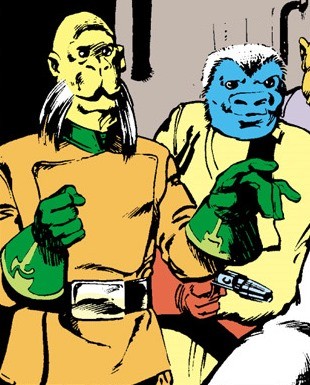And how Han lost his reward had at least three versions, by my tally.
The Legends term was chosen because, like historical legends, the idea going forward is that all, part, or none of those previous stories may be correct. Characters and concepts are being drawn from them all the time; it's just not necessarily the case that they're bringing every element of their past with them.
The Thrawn case one of the more obvious, but there are many lesser examples -- including Jabba's arranger Mosep Binneed, who I did stories with both before and during the Disney Era, and who is Star Wars' poster child for shared-universe self-repair. People of a certain age may recognize this fellow on the left:

He first appeared in the second Star Wars comic ever, identified as Jabba and speaking the character's cutting-room floor lines that would later appear in the Special Edition; Howard Chaykin just picked a random cantina alien for his visage. Once Return of the Jedi revealed Jabba's look, the many comics appearances of "Monkey Jabba" were generally considered apocryphal until the role-playing game established him as Binneed, who occasionally travels under Jabba's name. When I needed a mob accountant for the 2017 Canto Bight hardcover, the Story Group had no objection at all to my bringing him back; I wrote him exactly the same way as I had before and assumed his extensive Expanded Universe biography was generally unchanged -- he just didn't get into detail about it, because there wasn't a need to.
As I've said elsewhere here, that approach allows vast swaths of existing material to coexist in some form with the new stories; you're just not likely to see things nailed down before they need to be for story purposes. "When you define, you confine," my first Star Wars editor said, long before Disney was in the picture, and it's good advice.
We are all learning this process together -- best practices for licensed materials look a lot different in 2020 than they did in 2000 and 1980. Today's content-hungry world makes it much more likely that corporations will return for new visits to their existing franchise universes; as such, major changes like births, marriages, and deaths for screen characters are far less advisable than they once were for the smaller-audience media. But the repair techniques still work, and those who want everything to fit may find there's far more that can be reconciled than can't.
The Legends term was chosen because, like historical legends, the idea going forward is that all, part, or none of those previous stories may be correct. Characters and concepts are being drawn from them all the time; it's just not necessarily the case that they're bringing every element of their past with them.
The Thrawn case one of the more obvious, but there are many lesser examples -- including Jabba's arranger Mosep Binneed, who I did stories with both before and during the Disney Era, and who is Star Wars' poster child for shared-universe self-repair. People of a certain age may recognize this fellow on the left:

He first appeared in the second Star Wars comic ever, identified as Jabba and speaking the character's cutting-room floor lines that would later appear in the Special Edition; Howard Chaykin just picked a random cantina alien for his visage. Once Return of the Jedi revealed Jabba's look, the many comics appearances of "Monkey Jabba" were generally considered apocryphal until the role-playing game established him as Binneed, who occasionally travels under Jabba's name. When I needed a mob accountant for the 2017 Canto Bight hardcover, the Story Group had no objection at all to my bringing him back; I wrote him exactly the same way as I had before and assumed his extensive Expanded Universe biography was generally unchanged -- he just didn't get into detail about it, because there wasn't a need to.
As I've said elsewhere here, that approach allows vast swaths of existing material to coexist in some form with the new stories; you're just not likely to see things nailed down before they need to be for story purposes. "When you define, you confine," my first Star Wars editor said, long before Disney was in the picture, and it's good advice.
We are all learning this process together -- best practices for licensed materials look a lot different in 2020 than they did in 2000 and 1980. Today's content-hungry world makes it much more likely that corporations will return for new visits to their existing franchise universes; as such, major changes like births, marriages, and deaths for screen characters are far less advisable than they once were for the smaller-audience media. But the repair techniques still work, and those who want everything to fit may find there's far more that can be reconciled than can't.



 I know).
I know).